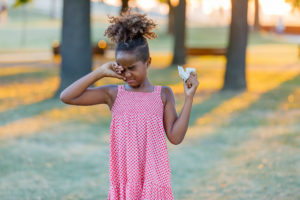January 3, 2022
By Judith Flanagan, PhD, Brien Holden Vision Institute
Reduced prevalence of dry eye in children, fewer subjective symptoms, and limitations of current diagnostic procedures may result in clinicians overlooking dry eye.

Dry eye disease is a chronic condition affecting up to 50% of the population, characterized by ocular discomfort and visual disturbances that can cause a significant decrease in quality of life.1 Contact lenses contribute to dry eye, with more than 50% of lens wearers reporting dry eye symptoms.2
Myopia is an epidemic among young people in East and Southeast Asia, with around 80% to 90% affected3 and up to 20% suffering high myopia.4 For myopia correction and control, soft contact lenses and orthokeratology are increasingly considered in children and teens. Although there have been reports of contact lens-related discomfort reported by children,5-7 the evidence on pediatric dry eye is not entirely clear, with some suggestions that pediatric patients, including pediatric lens wearers, may have fewer complaints than adults.8,9
OrthoK and Dry Eye
In a study comparing the vision-related quality of life with orthokeratology and single vision spectacles, 30% to 40% of children reported discomfort/itchy/burning/dry eyes after lens insertion.10 Interestingly, whether OrthoK contributes to or alleviates dry eye is not clear. The American Academy of Orthokeratology and Myopia Control (AAOMC) and the Orthokeratology Society of Oceania support OrthoK as appropriate for children unable to wear other lenses due to dry eye or allergies,11 while other evidence indicates dry eye as underdiagnosed in OrthoK wear.
For example, OrthoK wear was found to reduce the stability of tear film (increased evaporation and thinning) and was thought to induce ocular inflammation due to meibomian gland disruption.12-14 Tear film instability (and attendant sequelae) with OrthoK lens wear in children was ascribed to OrthoK-induced irregular corneal surface changes.15 Reports of no change in tear meniscus height or OSDI from pre-OrthoK levels after months of wear16 contrast with data suggesting initial increases in dry eye subsiding within the month of lens wear2 and possibly suggesting rapid neuronal adaptation in children.4
Although the relation between pediatric contact lens wear and dry eye is not entirely clear, there are certain important parameters that practitioners need to be aware of to deliver reduced rates of myopia progression, while offering improved quality of life with reasonable comfort. Compliance with lens wear is vital for efficacy, and studies have shown a complex relationship between overall comfort to adherence to lens wear and, therefore, efficacy.17
Tear Film Stability is Important for Pediatric Myopia Control15
Reports of increased partial blinking after OrthoK enrollment18 mandate increased observation of such. In relation to pediatric OrthoK patients’ tear film, lipid layer thickness in children requires different standards to adults. Hence, the usual Lipiview test might not be reliable in children.18 Also, it is essential to remember that allergic conjunctivitis has a higher prevalence in children and can induce dry eye, making dry eye diagnosis more difficult.19 Keratograph assessment detecting tear meniscus height and meibomian gland dropout perform well in children, especially in combination with questionnaires to facilitate dry eye diagnoses.19 For high myopes, targeted reduction of refractive error (RE) can require more pressure from lenses on the cornea, leading to increased staining, corneal and tear film irregularities, discomfort, and dry eye. To reduce this risk, partial reduction of RE might be considered,20 along with education and more frequent follow-ups.20
Finally, perceived poorer vision and comfort are related to reduced compliance, indicating the importance of communication, which can be difficult for children. Targeting males and those with lower myopia who show reduced adherence to myopia control lenses can also help adherence to lens wear.17
In summary, reduced prevalence of dry eye in children, fewer subjective symptoms, and limitations of current diagnostic procedures may result in clinicians overlooking dry eye.19 While contact lens platforms offer powerful myopia control for children, in prescribing, we should be mindful of the ocular surface of the patients, especially meibomian gland function and dry eye prevalence, which can reduce comfort and adherence, which ultimately leads to worse outcomes.19
SUMMARY:
To maximize the comfort of pediatric contact lens wearers, eye care practitioners should:
1. Be mindful that tear film stability impacts ocular discomfort, and therefore pay attention to meibomian glands, blinking rate, corneal staining, and subjective symptoms.
2. Be aware of the greater incidence of allergic conjunctivitis in children that might be confused with dry eye disease.
3. Be mindful of potential compliance issues related to poor vision, discomfort, male sex, and lower power of correction, all of which are reported markers of reduced compliance.
 |
Associate Professor Judith Flanagan received her PhD in Medicine from the Garvan Institute, Sydney. Her previous positions include a postdoctoral fellowship at the University of California, Berkeley, and an Assistant Professorship at the University of California, San Francisco. Most recently, Dr. Flanagan was employed by BHVI as the Scientific Writer and Head of Ocular Therapeutics. She currently consults in the arena of dry eye and ocular therapeutics. |
References
- Assessment, D.E. and M.S.R. Group, n− 3 Fatty Acid Supplementation for the Treatment of Dry Eye Disease. New England Journal of Medicine, 2018. 378(18): p. 1681-1690.
- Yan, Z., Dry eye symptoms and signs in children wearing OK lenses for six months in China. Journal francais d’ophtalmologie, 2020. 43(3): p. 211-215.
- Baird, P.N., et al., Myopia (Primer). Nature Reviews: Disease Primers, 2020. 6(1).
- Jin, W., et al., Short-term effects of overnight orthokeratology on corneal sensitivity in Chinese children and adolescents. Journal of ophthalmology, 2018. 2018.
- Sankaridurg, P., et al., Adverse events during 2 years of daily wear of silicone hydrogels in children. Optom Vis Sci, 2013. 90(9): p. 961-9.
- Wang, X., et al., The Influence of Overnight Orthokeratology on Ocular Surface and Meibomian Gland Dysfunction in Teenagers with Myopia. J Ophthalmol, 2019. 2019: p. 5142628.
- Jones, L.A., et al., Purchase of contact lenses and contact-lenses-related symptoms following the Contact Lenses in Pediatrics (CLIP) Study. Cont Lens Anterior Eye, 2009. 32(4): p. 157-63.
- Greiner, K.L. and J.J. Walline, Dry eye in pediatric contact lens wearers. Eye Contact Lens, 2010. 36(6): p. 352-5.
- Han, S.B., et al., Children with dry eye type conditions may report less severe symptoms than adult patients. Graefes Arch Clin Exp Ophthalmol, 2013. 251(3): p. 791-6.
- Yang, B., et al., Vision-related quality of life of Chinese children undergoing orthokeratology treatment compared to single vision spectacles. Contact Lens and Anterior Eye, 2021. 44(4): p. 101350.
- Haines, C. Dry Eye in Myopia Management. Myopia Profile 2021 [cited 2021 November 16]; Available from: https://www.myopiaprofile.com/dry-eye-in-myopia-management/.
- Yang, L., et al., The influence of overnight orthokeratology on ocular surface and dry eye-related cytokines IL-17A, IL-6, and PGE2 in children. Contact Lens and Anterior Eye, 2021. 44(1): p. 81-88.
- Na, K.-S., et al., The influence of overnight orthokeratology on ocular surface and meibomian glands in children and adolescents. Eye & contact lens, 2016. 42(1): p. 68-73.
- Liu, Y.M. and P. Xie, The safety of orthokeratology—a systematic review. Eye & contact lens, 2016. 42(1): p. 35.
- Cho, W.-H., et al., Analysis of tear film spatial instability for pediatric myopia under treatment. Scientific Reports, 2020. 10(1): p. 1-9.
- Carracedo, G., J.M. González-Méijome, and J. Pintor, Changes in diadenosine polyphosphates during alignment-fit and orthokeratology rigid gas permeable lens wear. Investigative ophthalmology & visual science, 2012. 53(8): p. 4426-4432.
- Weng, R., et al., Exploring non-adherence to contact lens wear schedule: Subjective assessments and patient related factors in children wearing single vision and myopia control contact lenses. Contact Lens and Anterior Eye, 2021. 44(1): p. 94-101.
- Zeng, L., et al., Tear Lipid Layer Thickness in Children after Short-Term Overnight Orthokeratology Contact Lens Wear. Journal of Ophthalmology, 2020. 2020.
- Wang, X., et al., Evaluation of dry eye and meibomian gland dysfunction in teenagers with myopia through noninvasive keratograph. Journal of ophthalmology, 2016. 2016.
- Hu, P., et al., The safety of orthokeratology in myopic children and analysis of related factors. Contact Lens and Anterior Eye, 2021. 44(1): p. 89-93.













